Muck is a type of organic sediment that can accumulate in lakes and ponds, often consisting of decomposing plant material, algae, and other organic matter. It can have a variety of negative impacts on the health of a lake or pond, including low oxygen levels, reduced water clarity, and the release of harmful gases. Muck can also contribute to the proliferation of harmful algae blooms, which can be toxic to aquatic life and humans.
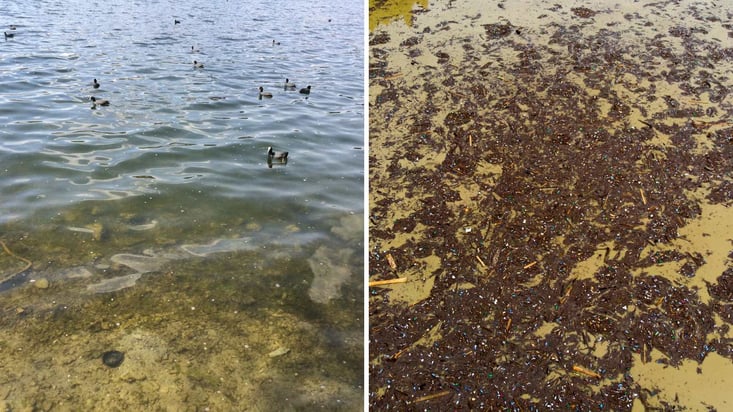
Muck’s negative impacts on lake health
Low Oxygen Levels
Muck buildup contributes to low oxygen levels, also known as hypoxia, in lakes which can have several negative effects on the lake's ecosystem and the organisms that rely on it. Here are some reasons why low oxygen levels in lakes are a concern:
- Harmful to fish and other aquatic life: Fish and other aquatic organisms require oxygen to survive. When oxygen levels in a lake drop too low, it can lead to fish kills, which can result in the loss of valuable fish populations. In addition, low oxygen levels can also affect other aquatic organisms, including invertebrates and amphibians, leading to declines in biodiversity.
- Negatively impacts nutrient cycles: Low oxygen levels can alter nutrient cycles in a lake, leading to changes in the way that nutrients are used and recycled within the ecosystem. This can have a significant impact on the growth and survival of plants and animals in the lake.
- Can lead to the formation of harmful algal blooms: Low oxygen levels can promote the growth of certain types of algae, including harmful algal blooms. These blooms can release toxins that can be harmful to fish and other organisms, as well as to humans who come into contact with the water.
- Can cause poor water quality: When oxygen levels in a lake drop, it can also affect the overall quality of the water. Low oxygen levels can lead to the buildup of organic matter, which can cause the water to become cloudy and foul-smelling.
Overall, low oxygen levels in lakes can have a significant impact on the health and biodiversity of the ecosystem, and it is important to monitor and address these issues to ensure the long-term sustainability of these important resources.
Reduced Water Clarity & Increased Nutrient Release
Muck reduces water clarity when resuspended in the water column, negatively impacting aquatic life and reducing the lake’s recreational value. Muck accumulates in a lake by nutrient runoff from surrounding land, such as fertilizers, pollutants, and other chemicals, and under anaerobic (without oxygen) conditions will be processed by inefficient bacteria. As muck decomposes, it releases nutrients and foul-smelling gases into the water, which can have several negative impacts on the health and balance of the ecosystem:
- Eutrophication: Nutrient release, particularly of nitrogen and phosphorus, can lead to eutrophication, a process where excessive nutrients in the water stimulate the growth of algae and aquatic plants. Under certain conditions, this can result in the formation of large algal blooms that can deplete oxygen levels in the water, leading to fish kills and other negative impacts on aquatic life.
- Harmful algal blooms: Excessive nutrient levels in lakes and ponds can lead to the formation of harmful algal blooms (HABs), which can release toxins that are harmful to humans and wildlife. These toxins can cause skin irritation, respiratory problems, and even liver damage.
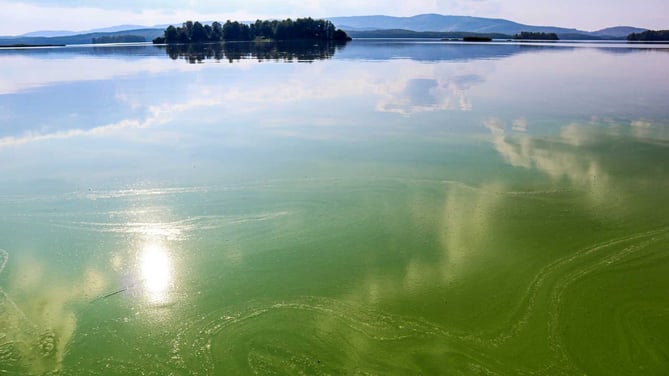
- Reduced water clarity: Algae and other aquatic plants that grow in response to excessive nutrient levels can reduce water clarity, making it difficult for aquatic plants to photosynthesize and for fish to find their prey.
- Negative changes in aquatic species composition: Changes in nutrient levels can lead to changes in the composition of aquatic species. Some species may thrive with increased nutrient levels, while others may decline or disappear altogether.
Overall, nutrient release in lakes and ponds can have significant negative impacts on the health and balance of the ecosystem. It is important to manage nutrient levels to ensure the long-term sustainability of these valuable resources. This can be done through practices such as reducing nutrient runoff from agricultural and urban areas, managing wastewater and sewage, and limiting the use of fertilizers and other sources of excess nutrients.
Release of Harmful Gases
Muck in lakes is a combination of organic matter that accumulates at the bottom of the lake over time. As this organic matter decomposes, it can produce a variety of harmful gases. Here are some of the gases that can be produced by muck in lakes:
- Methane: Methane is a potent greenhouse gas that is produced when organic matter decomposes in the absence of oxygen. Muck in lakes can be a significant source of methane emissions.
- Hydrogen sulfide (H2S): Hydrogen sulfide is a toxic gas that can be produced when organic matter decomposes in the absence of oxygen. This gas has a distinct rotten egg odor and can be harmful to fish and other aquatic life at high concentrations.
- Carbon dioxide: Carbon dioxide is a naturally occurring gas that is produced during the decomposition of organic matter. While it is not as harmful as methane or hydrogen sulfide, high concentrations of carbon dioxide can be a concern for aquatic life if they are present in the water at levels that exceed natural levels.
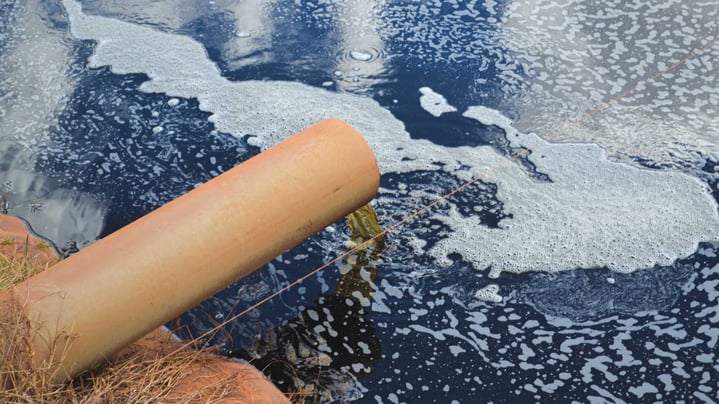
The gases produced by muck in lakes can have negative impacts on the health and balance of the ecosystem. It is important to manage muck levels in lakes to prevent excessive organic matter buildup and reduce the production of harmful gases. This can be done through practices such as reducing nutrient inputs to the lake, managing shoreline erosion, and dredging muck from the lake bottom.
Spread of Harmful Algae Blooms
Muck can also lead to the proliferation of harmful algae blooms, which can be toxic to aquatic life and humans. Muck accumulation in lakes can contribute to the spread of harmful algal blooms (HABs) in several ways:
Nutrient Release: Muck can contain high levels of nutrients such as nitrogen and phosphorus. As muck decomposes, these nutrients are released into the water, which can contribute to the growth of algae and cyanobacteria that can cause HABs.
Sediment Resuspension: Muck can also contribute to the resuspension of sediment in the water. When sediment is resuspended, it can carry nutrients and other pollutants into the water column, which can fuel the growth of HABs.
Algal Seed Bank: Muck can act as a seed bank for harmful algae. Some species of algae can survive in muck for years, and when the conditions are favorable, they can quickly reproduce and cause HABs.
Low Oxygen Levels: As muck decomposes, it consumes oxygen, which can lead to low oxygen levels in the water. This can create an environment that is favorable for the growth of some types of harmful algae that thrive in low-oxygen conditions.
Muck accumulation in lakes can contribute to the spread of HABs through nutrient release, sediment resuspension, the presence of an algal seed bank, and the creation of low-oxygen conditions. Managing muck levels in lakes through practices such as dredging and reducing nutrient inputs can help to reduce the risk of HABs and protect the health and balance of the lake ecosystem.
Removing Muck from Lakes and Ponds
There are several ways that muck can be controlled, including physical, chemical and chemical-free methods. Physical methods tend to be a last resort option for most lake and pond managers because they disturb the ecology and tend to be expensive and time-consuming. Many chemical and natural control methods are available with varying levels of efficiency, environmental impact and cost.
Physical Methods To Remove Muck from lakes
Dredging
One physical method of muck control is dredging, which involves removing the muck from the bottom of the lake or pond using specialized equipment. This can be an effective method of muck control, but it can also be costly and can have negative impacts on the environment, such as disturbing the habitat of aquatic organisms or releasing nutrients back into the water.
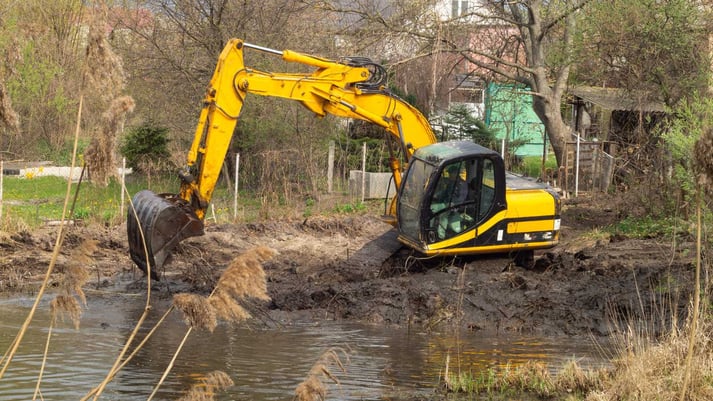
Barriers
Another physical method of muck control is the use of barriers, which can help to prevent the accumulation of new muck by blocking sediment and nutrients from entering the water. This can be an effective method of muck control, but it can also be costly and may not be practical in all situations.
Chemical Methods To Remove Muck from Lakes
Chemical methods of muck control include the use of algaecides and herbicides to kill off aquatic plants and algae, and the use of enzymes and bacteria to break down the organic matter in the muck. These methods can be effective, but they can also have negative impacts on the environment and should be used with caution.
Chemical-Free Muck Reduction
In recent years, there has been a trend toward the use of more environmentally friendly and sustainable methods of muck control, such as the use of native plants, natural enzymes and bacteria to break down the muck. These methods can be effective at controlling muck while minimizing negative impacts on the environment, and when used with nanobubble technology, lake managers see increased resiliency and sustainability of water quality metrics.
Nanobubble Technology
As opposed to conventional aeration that produces larger-sized bubbles that float to the surface and pop, nanobubble technology creates nano-sized bubbles that stay suspended in water for long periods of time and have unique properties and behaviors that are beneficial to lakes and ponds.
When nanobubbles are introduced to muck in lakes or ponds, they can help increase natural muck digestion by providing a source of oxygen for the microorganisms that break down the organic matter in the muck.
Here are some of the ways that nanobubbles can help increase muck digestion:
- Improved Oxygen Transfer: Nanobubble technology transfers gas at a high rate of efficiency and nanobubbles promote the stability of the oxygen, allowing gas to penetrate the sediment layer and throughout the water column., Microorganisms in the muck receive more oxygen and this helps create an environment more conducive to muck digestion.
- Increased Microbial Activity: The oxygen provided by nanobubble technology can stimulate the growth and activity of aerobic microorganisms that digest organic matter in the muck. This helps to increase the rate of muck digestion and reduce muck accumulation in the lake or pond.
- Reduced Sediment Resuspension: When muck accumulates at the bottom of a lake or pond, it can become unstable and easily disturbed. This can lead to sediment resuspension, which can release nutrients and other pollutants into the water column. By increasing muck digestion, nanobubbles can help to reduce muck accumulation and stabilize the sediment at the bottom of the lake or pond, which can reduce sediment resuspension.
Nanobubbles have no negative impacts on the environment compared to chemical and physical methods. For example, chemical algaecides and herbicides can be toxic to aquatic life and may also interfere with the natural balance of the ecosystem. In contrast, nanobubbles are simply tiny gas bubbles that are able to help promote the breakdown of organic matter by aerobic bacteria.
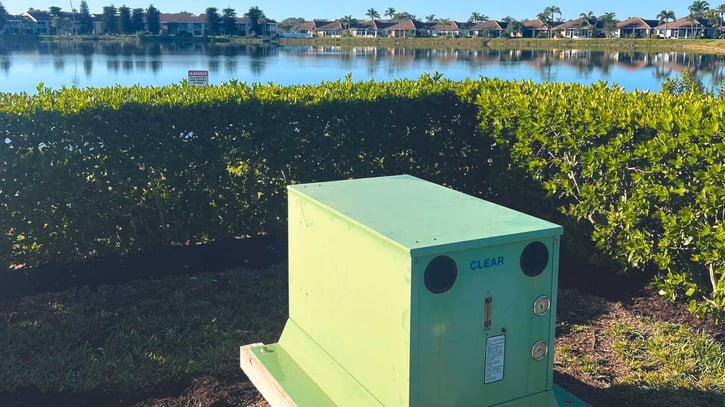
Overall, the introduction of nanobubbles to lakes and ponds can help to increase muck digestion by providing a source of oxygen for the microorganisms that break down organic matter in the muck. This can lead to a reduction in muck accumulation, improved water quality, and a healthier ecosystem.
Nanobubble technology is a cost-effective, chemical-free tool for improving the health of lakes and ponds by helping increase muck digestion. Learn more about Moleaer’s nanobubble generation products for lakes and ponds.


